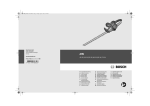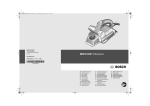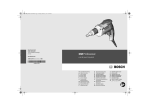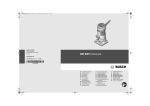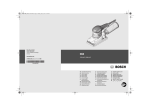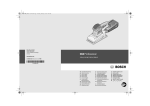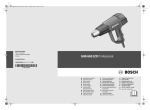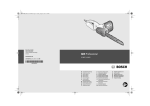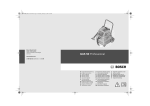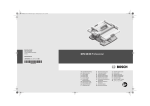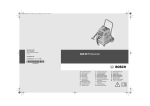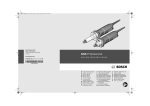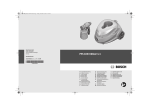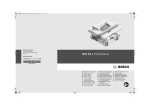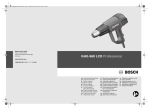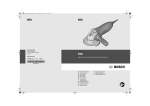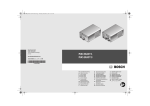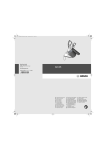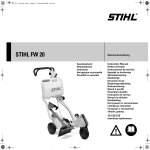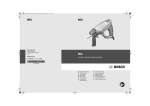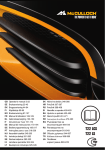Download PPR 250 - Tooled
Transcript
OBJ_BUCH-1513-003.book Page 1 Monday, January 16, 2012 11:29 AM Robert Bosch GmbH Power Tools Division 70745 Leinfelden-Echterdingen Germany PPR 250 www.bosch-pt.com 2 609 005 736 (2012.01) PS / 172 UNI de en fr es pt it nl Originalbetriebsanleitung Original instructions Notice originale Manual original Manual original Istruzioni originali Oorspronkelijke gebruiksaanwijzing da Original brugsanvisning sv Bruksanvisning i original no Original driftsinstruks fi Alkuperäiset ohjeet el tr pl cs sk hu ru Ðñùôüôõðï ïäçãéþí ÷ñÞóçò Orijinal işletme talimat Instrukcja oryginalna Původní návod k používání Pôvodný návod na použitie Eredeti használati utasítás Îðèãèíàëüíîå ðóêîâîäñòâî ïî ýêñïëóàòàöèè uk Îðèã³íàëüíà ³íñòðóêö³ÿ ç åêñïëóàòàö³¿ ro Instrucţiuni originale bg Îðèãèíàëíà èíñòðóêöèÿ sr sl hr et lv lt Originalno uputstvo za rad Izvirna navodila Originalne upute za rad Algupärane kasutusjuhend Instrukcijas oriģinālvalodā Originali instrukcija OBJ_BUCH-1513-003.book Page 2 Monday, January 16, 2012 11:29 AM 2| Deutsch . . . . . . . . . . . . . . . . . . . . . . . . . . . . . . . . . . . . . . . . . Seite 9 English . . . . . . . . . . . . . . . . . . . . . . . . . . . . . . . . . . . . . . . . . . Page 15 Français . . . . . . . . . . . . . . . . . . . . . . . . . . . . . . . . . . . . . . . . . Page 21 Español . . . . . . . . . . . . . . . . . . . . . . . . . . . . . . . . . . . . . . . .Página 27 Português. . . . . . . . . . . . . . . . . . . . . . . . . . . . . . . . . . . . . . .Página 34 Italiano . . . . . . . . . . . . . . . . . . . . . . . . . . . . . . . . . . . . . . . . .Pagina 40 Nederlands . . . . . . . . . . . . . . . . . . . . . . . . . . . . . . . . . . . . .Pagina 46 Dansk . . . . . . . . . . . . . . . . . . . . . . . . . . . . . . . . . . . . . . . . . . . Side 52 Svenska . . . . . . . . . . . . . . . . . . . . . . . . . . . . . . . . . . . . . . . . . Sida 57 Norsk . . . . . . . . . . . . . . . . . . . . . . . . . . . . . . . . . . . . . . . . . . . Side 63 Suomi. . . . . . . . . . . . . . . . . . . . . . . . . . . . . . . . . . . . . . . . . . . .Sivu 68 ÅëëçíéêÜ. . . . . . . . . . . . . . . . . . . . . . . . . . . . . . . . . . . . . . . . Óåëßäá 74 Türkçe . . . . . . . . . . . . . . . . . . . . . . . . . . . . . . . . . . . . . . . . . Sayfa 80 Polski . . . . . . . . . . . . . . . . . . . . . . . . . . . . . . . . . . . . . . . . . .Strona 86 Česky . . . . . . . . . . . . . . . . . . . . . . . . . . . . . . . . . . . . . . . . . . Strana 92 Slovensky. . . . . . . . . . . . . . . . . . . . . . . . . . . . . . . . . . . . . . . Strana 98 Magyar . . . . . . . . . . . . . . . . . . . . . . . . . . . . . . . . . . . . . . . . . . Oldal 104 Ðóññêèé . . . . . . . . . . . . . . . . . . . . . . . . . . . . . . . . . . . . . Ñòðàíèöà 110 Óêðà¿íñüêà. . . . . . . . . . . . . . . . . . . . . . . . . . . . . . . . . . . .Ñòîð³íêà 117 Română . . . . . . . . . . . . . . . . . . . . . . . . . . . . . . . . . . . . . . . .Pagina 123 Áúëãàðñêè . . . . . . . . . . . . . . . . . . . . . . . . . . . . . . . . . . . Ñòðàíèöà 129 Srpski. . . . . . . . . . . . . . . . . . . . . . . . . . . . . . . . . . . . . . . . . . Strana 136 Slovensko . . . . . . . . . . . . . . . . . . . . . . . . . . . . . . . . . . . . . . . Stran 142 Hrvatski . . . . . . . . . . . . . . . . . . . . . . . . . . . . . . . . . . . . . . Stranica 147 Eesti . . . . . . . . . . . . . . . . . . . . . . . . . . . . . . . . . . . . . . . . . Lehekülg 153 Latviešu . . . . . . . . . . . . . . . . . . . . . . . . . . . . . . . . . . . . . . Lappuse 159 Lietuviškai . . . . . . . . . . . . . . . . . . . . . . . . . . . . . . . . . . . . Puslapis 165 2 609 005 736 | (16.1.12) Bosch Power Tools OBJ_BUCH-1513-003.book Page 3 Monday, January 16, 2012 11:29 AM |3 3 2 4 5 1 PPR 250 8 9 19 7 20 18 21 22 23 24 10 26 11 25 6 12 14 15 16 Bosch Power Tools 27 28 29 13 15 2 609 005 736 | (16.1.12) OBJ_BUCH-1513-003.book Page 4 Monday, January 16, 2012 11:29 AM 4| A 21 12 3 B1 2 2 3 10 12 B2 1 2 12 8 8 3 2 609 005 736 | (16.1.12) 1 6 Bosch Power Tools OBJ_BUCH-1513-003.book Page 5 Monday, January 16, 2012 11:29 AM |5 C1 29 C2 D 27 18 28 23 E1 E2 37 3 16 15 15 17 17 16 Bosch Power Tools 15 2 609 005 736 | (16.1.12) OBJ_BUCH-1513-003.book Page 6 Monday, January 16, 2012 11:29 AM 6| F 14 G1 M22 M24 31 31 30 30 G2 27 20 + 32 21 23 22 2 609 005 736 | (16.1.12) Bosch Power Tools OBJ_BUCH-1513-003.book Page 7 Monday, January 16, 2012 11:29 AM |7 G3 3 31 27 32 34 G4 20 33 H 35 Bosch Power Tools 2 609 005 736 | (16.1.12) OBJ_BUCH-1513-003.book Page 8 Monday, January 16, 2012 11:29 AM 8| I1 I2 36 36 37 I3 2 609 005 736 | (16.1.12) 38 Bosch Power Tools OBJ_BUCH-1513-003.book Page 16 Monday, January 16, 2012 11:29 AM 16 | English Symbol Meaning Adapting the height-adjustable paintbucket coupling to the height of the paint bucket: base unit must always stand level on the flor. leftward Pump lock engaged (pump function possible only in this position) rightward Pump lock disengaged Product Description and Specifications Intended Use The machine is intended only for painting water-based dispersion wall paint. Use the machine only when you can fully assess all functions and handle them without limitation, or after having received appropriate instructions. Product Features The numbering of the components shown refers to the representation of the power tool on the graphic pages. 1 Paint applicator extension 2 Feed hose 3 Paint applicator 4 Intake hose 5 Base unit Paint applicator 6 Remote control holder 7 Trigger switch 8 Remote control (PaintControl system) 9 Extension handle 10 Screw connection of extension 11 Paint applicator handle 12 Guide groove for feed hose 13 Feed-hose connection on paint applicator 14 Bucket holder 15 Roll holder 16 Paint roll 17 Roll axle Base unit 18 On/Off switch 19 Carrying handle 20 Pump lid 21 Holding clamp 22 Paint filter 2 609 005 736 | (16.1.12) 23 24 25 26 27 28 29 Pump lock Pedestal Pump-hose connection Feed-hose connection on base unit Double-SDS-connector Pump-hose holding clip Height-adjustable paint-bucket coupling Components for cleaning 30 Mixing-nozzle spanner 31 Water tap-adapter with gasket 32 SDS connection on paint filter 33 Pump hose 34 Bypass hose 35 Rotor 36 Paint distributor 37 Paint chamber 38 Distributor plate *Accessories shown or described are not part of the standard delivery scope of the product. A complete overview of accessories can be found in our accessories program. Technical Data Electric Paint Roller Article number Rated power input Paint delivery capacity Required time for application of paint on 2 m2 Length – Paint applicator – Paint applicator + extension – Feed hose Dimensions of paint roll – Width – Shank diameter – Core diameter (incl. pile) – Pile height – Pile material Weight according to EPTA-Procedure 01/2003 Protection class – Base unit – Trigger switch with remote control PPR 250 3 603 BA0 0.. W 35 ml/min 400 min 1 cm cm m 40 120 5 cm mm mm mm 25 8 45–50 11 Polyester kg 3.7 * Protection against water splash from all directions IP X4 * IP X5 ** ** Protection against water jets from all directions The values given are valid for a nominal voltage [U] of 230 V. For different voltages and models for specific countries, these values can vary. Please observe the article number on the type plate of your machine. The trade names of the individual machines may vary. Noise Information Typically the A-weighted sound pressure level of the product is less than 70 dB(A). Bosch Power Tools OBJ_BUCH-1513-003.book Page 17 Monday, January 16, 2012 11:29 AM English | 17 Declaration of Conformity We declare under our sole responsibility that the product described under “Technical Data” is in conformity with the following standards or standardization documents: EN 60335, EN 300 220-1:2006, EN 300 220-2:2007, EN 301 4891:2008, EN 301 489-3:2002 according to the provisions of the directives 2011/65/EU, 2006/95/EC, 2004/108/EC, 1999/5/EC. 11 Dr. Egbert Schneider Dr. Eckerhard Strötgen Senior Vice President Engineering Director Engineering PT/ESI – Cover or mask off floors, furnishings, door and window frames, etc. – Also, sufficiently underlay the paint bucket and base unit with covering-off material (foil, cardboard, etc.). Preparing the Paint – Prepare the paint according to the manufacturer’s instructions. – Stir paint thoroughly and dilute as required. When the painting result is not satisfactory or no paint comes out: See “Correction of Malfunctions”, page 18. f Before any work on the machine itself, pull the mains plug. Coupling the Base Unit and the Paint Bucket (see figures C1–C2) – Set down base unit 5 level on the floor next to the opened paint bucket. – Pull the height-adjustable paint-bucket coupling 29 upward to the stop. – Hold the paint bucket handle upright and slide the hooks of the paint-bucket coupling down to the edge of the paint bucket. The paint bucket handle must always be positioned between the hooks of the paint-bucket coupling. – Insert the paint filter 22 to the bottom of the paint bucket. – Fasten the intake hose 4 in the holding clip 28. Unreel the Feed Hose (see figure A) Starting Operation Robert Bosch GmbH, Power Tools Division D-70745 Leinfelden-Echterdingen Leinfelden, 26.09.2011 Assembly – Open holding clamp 21 and completely unreel feed hose 2 from base unit 5. – Lock holding clamp 21 again. Note: When painting only with the paint applicator 3 (without extension 1), the feed hose 2 can be fastened in one of the two exterior guide grooves 12 for more convenient working. Mounting the Extension (see figures B1 – B2) – Screw the screw connection 10 of the extension into the paint applicator 3. – Fasten feed hose 2 in the straight guide grooves 12 of paint applicator 3 and extension 1. – Remove remote control 8 from paint applicator 3 and clip it into holder 6 of extension 1. Operation f Before any work on the machine itself, pull the mains plug. Preparing for Operation f Working close to the edge of open waters or on neighbouring areas in the direct vicinity of open waters is not permitted. When purchasing paint, observe its environmental compatibility. Preparing the Surface to be Painted The surface to be painted must be clean, dry and free of grease. When working indoors, all non-covered surface can be soiled. Therefore, thoroughly prepare the area around the surface to be painted: Bosch Power Tools f Observe correct mains voltage! The voltage of the power source must agree with the voltage specified on the nameplate of the machine. Power tools marked with 230 V can also be operated with 220 V. f Always place the base unit and the paint bucket on a level surface. When operating the paint roller on a ladder or an inclined surface, the base unit and the paint bucket can tip over or fall down. This can lead to injury and contamination from the coating material. f Do not cover off the base unit. Otherwise, a possible malfunction cannot be detected. f Keep other electrical machines/devices away while using the paint roller or cover them off adequately. Possibly occurring paint splashes can lead to accidents and soiling. f Regularly provide for proper ventilation in the working range and for sufficient fresh air throughout the complete area. f Wear safety glasses/goggles. This will protect your eyes against splashing or ejected paint. Wear appropriate work clothes. Paint is difficult to remove from clothing. Prevent the hose system from being constricted, e. g., through crushing, kinking or pulling! Do not stand on the feed hose 2. Keep the hose system away from heat sources. Do not pull the hoses. Especially when moving the base unit, do not pull it by the feed hose 2. Carry the base unit only by the carrying handle 19. 2 609 005 736 | (16.1.12) OBJ_BUCH-1513-003.book Page 18 Monday, January 16, 2012 11:29 AM 18 | English Switching On (see figure D) – Plug the mains plug into a socket outlet. – Make sure that the pump lock 23 is engaged. – To start the machine, push the On/Off switch 18 to the “I” position. – Grasp the paint applicator 3 or extension 1 by the respective handle and direct the paint roll 16 toward the surface to be painted. – Press the trigger switch 7 on the remote control 8. Switching Off – Release the trigger switch 7. – To switch off the machine, push the On/Off switch 18 to the “0” position. – Pull the mains plug from the socket outlet. – Disengage pump lock 23. To relieve the lock tension, lightly push the pump lid 20 upward, if required. Working Advice Painting Before painting, moisten new or dried paint rolls with water. When the paint roll is new or dry, it takes approx. six lanes until the paint application is homogeneous and without streaks. Filling an empty feed hose takes approx. one minute. – Press the trigger switch 7 to apply a sufficient amount of paint on the paint roll 16 and uniformly move the paint roll up and down. – Avoid interruptions within the surface to be painted. Evenly guiding the paint roll will lead to a uniform surface quality. Regulating the Paint Amount during Painting The paint amount can be regulated with the trigger switch. – Press the trigger switch 7 until the application of paint on the paint roll is homogeneous. – Afterwards, release the trigger switch until the application of paint on the painting surface is no longer opaque. – Then, refill the paint chamber again with a sufficient amount of paint (press trigger switch 7 approx. 5 seconds). Changing the Paint Roll (see figures E1 – E2) Remove the paint roll from the paint applicator for cleaning or when the paint roll is worn. – Pull the roll holders 15 apart and allow the paint roll 16 to slide out of the paint applicator 3. To prevent the paint-soaked paint roll from drying out until it has been washed out, it is best to immerse it into a water bucket. Appropriate new paint rolls can be found in our Bosch accessories program. Paint rolls from other manufacturers can also be used, when the respective dimensions are observed (see “Technical Data”, page 16). Insert a new paint roll as follows: – Pull the roll axle 17 out of the old paint roll 16 and slide the new paint roll on the roll axle until centred. – Insert the roll axle 17 on one side in the roll holder 15 until it fits. – Press the paint roll into the roll holder of the other side. The paint roll must be able to rotate freely. Placing Down the Paint Applicator (see figure F) – Place down the paint applicator 3 on the edge of the paint bucket so that it rests on the bucket holder 14. Correction of Malfunctions Problem Paint application unsatisfactory. No paint coming out of paint applicator 3. The remote control 8 is inoperative. 2 609 005 736 | (16.1.12) Cause The hoses are obstructed. No or too little paint being transported. The paint is too viscous and therefore cannot be transported. The pump lock 23 is not engaged. Corrective Measure Make sure that non of the hoses are squeezed or creased. Stir paint thoroughly and dilute as required. Make sure that pump lid 20 is properly inserted and locked. The paint bucket is empty. Refill the paint bucket with fresh paint or exchange the empty paint bucket against a full one. The paint is too viscous and cannot be drawn Stir paint thoroughly and dilute as required. in by the pump. The hoses are obstructed. Clean the hose system (see “Cleaning”, page 19). The hoses are obstructed. No or too little Make sure that non of the hoses are squeezed or paint being transported. creased. The base unit is switched off. Switch the base unit on (see “"Switching On"Switching On”, page 18). The remote control battery is empty. Contact an authorised service agent for Bosch power tools. Have the component replaced there. Bosch Power Tools OBJ_BUCH-1513-003.book Page 19 Monday, January 16, 2012 11:29 AM English | 19 Maintenance and Service f Before any work on the machine itself, pull the mains plug. Cleaning After painting, the system must be pumped empty and all paint-carrying parts must be cleaned. There are two possibilities for cleaning the system: – EasyClean: Using universal connectors, the system is connected to a water tap and flushed. – Alternative possibility: The system pumps fresh water from a bucket for cleaning. Proper cleaning is a prerequisite for perfect operation of the electric paint roller. No warranty claims can be undertaken if cleaning is not carried out or is carried out incorrectly. Keep the base unit, the holding clip 28 and the remote control 8 clean. Clean them with a moist cloth. The base unit and the remote control may not be immersed into water. Always clean the paint roll, the paint applicator and the hose system with water. Preparation – Place down the paint applicator 3 on the edge of the paint bucket so that it rests on the bucket holder 14. – Loosen the double-SDS-connector 27 from the holding clip 28 and completely remove the intake hose 4 and the paint filter 22 from the paint bucket. – Remove the paint roll 16 from the paint applicator 3 (see “Changing the Paint Roll”, page 18). – Hold the paint applicator 3 above the paint bucket and press the trigger switch 7 until the hose system is pumped empty and no more paint comes out of the paint applicator. – Release the trigger switch 7 and switch the power tool off. – Pull the mains plug from the socket outlet. EasyClean (see figures G1–G4) Note: Use only the supplied hoses and adapters for connecting to the water supply. Preparing the water tap: – Unscrew the mixing nozzle from a water tap using the supplied mixing-nozzle spanner 30 or a suitable tool. – Screw the fitting adapter 31 (M22 or M24 thread) in or on the water tap. Additional water-tap adapters are available in the Bosch accessories program. Separating paint-carrying components: – Unlatch holding clamp 21. – Disengage pump lock 23. To relieve the lock tension, lightly push the pump lid 20 upward, if required. – Push the pump lid 20 downward to the stop and then carefully lift it out of the housing opening of base unit 5. – Loosen the SDS connection 32 at the bottom part of the intake hose 4. Bosch Power Tools Flushing the system: – Carry the paint applicator 3, feed hose 2, pump lid 20 and intake hose 4 to the prepared water tap. Please note that paint may escape or leak from the system. – Attach the double-SDS-connector 27 to adapter 31 on the water tap. – Hold the paint applicator 3 over a suitable collecting container (e. g. a bucket). – Carefully open the water tap and run lukewarm water through the system. – When flushing, lightly press pump hose 33 together several times. This will lead to better cleaning results. Additionally, this also cleans bypass hose 34, which prevents the rotor from overloading in case of excessive pressure in the hose system. – Flush the system until only clear water comes out of the paint applicator. – Clean the paint filter 22 and the intake hose 4 (connect SDS connection 32 to the water tap and flush; additional cleaning of paint filter with brush). – Release the adapter 31 from the water tap and from the double-SDS-connector 27. Screw the mixing nozzle back onto water tap. Cleaning the paint applicator and the paint roll: – See “Cleaning the Paint Applicator and the Paint Roll”, page 20. Mounting together the dried components: – Allow all components to dry thoroughly. If possible, hang up the paint roll 16 to dry. If the paint roll is placed down to dry, the pile will be deformed. This may lead to an uneven surface quality when using the paint roller the next time. – Reconnect the intake hose 4 to the SDS connection 32 on the paint filter 22. – Manually turn rotor 35 to the indicated position (see figure G4) in order to avoid damage to pump hose 33 when inserting pump lid 20. – Reinsert the pump lid 20 into the housing opening and push it upward to the stop. – Shut pump lock 23 until it engages. – Lock holding clamp 21 again. Alternative Cleaning Method (see figure H) Note: This cleaning method takes somewhat longer than the EasyClean method. – Couple base unit 5 to the water bucket (also see “Coupling the Base Unit and the Paint Bucket”, page 17). – Insert paint filter 22 to the bottom of the water bucket. – Fasten the intake hose 4 in the holding clip 28. – Plug the mains plug into a socket outlet. – Make sure that the pump lock 23 is engaged. – To start the machine, push the On/Off switch 18 to the “I” position. – Hold paint applicator 3 over a suitable collecting container (e.g. a bucket) and actuate trigger switch 7 until only clear water comes out of the paint applicator and no more paint can be seen in the hoses (visual check). 2 609 005 736 | (16.1.12) OBJ_BUCH-1513-003.book Page 20 Monday, January 16, 2012 11:29 AM 20 | English Always lightly move the hoses. This will lead to better cleaning results. – Clean the paint applicator and the paint roll: See “Cleaning the Paint Applicator and the Paint Roll”, page 20. – Allow all components to dry thoroughly. If possible, hang up the paint roll 16 to dry. If the paint roll is placed down to dry, the pile will be deformed. This may lead to an uneven surface quality when using the paint roller the next time. Cleaning the Paint Applicator and the Paint Roll (see figures I1–I3) After flushing the system, some of the components still have to be cleaned manually. – Remove paint remainders from paint applicator 3 using a brush. – Pull paint distributor 36 out of the paint chamber 37. For easier cleaning, turn the paint distributor by 90°. – Remove the distributor plate 38 from the paint distributor 36. For this, lift the distributor plate on one side and pull it laterally out of the retaining clamps. – Remove paint remainders from of the distributor plate 38, the paint distributor 36 and from of the paint chamber 37 using a small brush. – Wash out the paint roll 16 thoroughly. Storage Before storing, the electric paint roller must be properly cleaned and all components dried. – Slide distributor plate 38 laterally into the retaining clamps in paint distributor 36. – Clip paint distributor 36 into the paint chamber 37. – Wind up feed hose 2 around the base unit 5 and affix it with holding clamp 21. – Slide down paint-bucket coupling 29 completely to the bottom. – Insert paint roll 16 into paint applicator 3 (see “Changing the Paint Roll”, page 18). Material Disposal Paint and dried paint remainders must be disposed of in an environmentally-friendly manner. Observe the manufacturer’s instructions for disposal and the local regulations for hazardous waste disposal. Chemicals harmful to the environment may not be disposed of into soil, groundwater or bodies of water. Never pour chemicals harmful to the environment into the sewerage system! Maintenance If the replacement of the supply cord is necessary, this has to be done by Bosch or an authorized Bosch service agent in order to avoid a safety hazard. If the machine should fail despite the care taken in manufacturing and testing procedures, repair should be carried out by an after-sales service centre for Bosch power tools. In all correspondence and spare parts order, please always include the 10-digit article number given on the type plate of the machine. 2 609 005 736 | (16.1.12) After-sales Service and Customer Assistance Our after-sales service responds to your questions concerning maintenance and repair of your product as well as spare parts. Exploded views and information on spare parts can also be found under: www.bosch-pt.com Our customer service representatives can answer your questions concerning possible applications and adjustment of products and accessories. Great Britain Robert Bosch Ltd. (B.S.C.) P.O. Box 98 Broadwater Park North Orbital Road Denham Uxbridge UB 9 5HJ Tel. Service: +44 (0844) 736 0109 Fax: +44 (0844) 736 0146 E-Mail: [email protected] Ireland Origo Ltd. Unit 23 Magna Drive Magna Business Park City West Dublin 24 Tel. Service: +353 (01) 4 66 67 00 Fax: +353 (01) 4 66 68 88 Australia, New Zealand and Pacific Islands Robert Bosch Australia Pty. Ltd. Power Tools Locked Bag 66 Clayton South VIC 3169 Customer Contact Center Inside Australia: Phone: +61 (01300) 307 044 Fax: +61 (01300) 307 045 Inside New Zealand: Phone: +64 (0800) 543 353 Fax: +64 (0800) 428 570 Outside AU and NZ: Phone: +61 (03) 9541 5555 www.bosch.com.au Republic of South Africa Customer service Hotline: +27 (011) 6 51 96 00 Gauteng – BSC Service Centre 35 Roper Street, New Centre Johannesburg Tel.: +27 (011) 4 93 93 75 Fax: +27 (011) 4 93 01 26 E-Mail: [email protected] Bosch Power Tools













